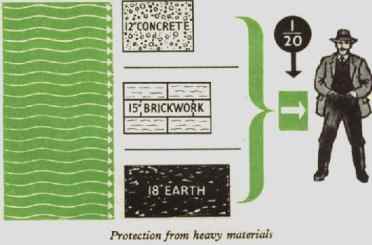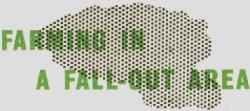Home Defence and the Farmer
If this country were to be attacked with nuclear weapons, many farms would be damaged or set on fire, even though they might be well away from where the explosions occurred. In addition, there would be a grave risk that highly dangerous radioactive dust (or fall-out) resulting from the explosions would be spread over wide areas of the countryside.
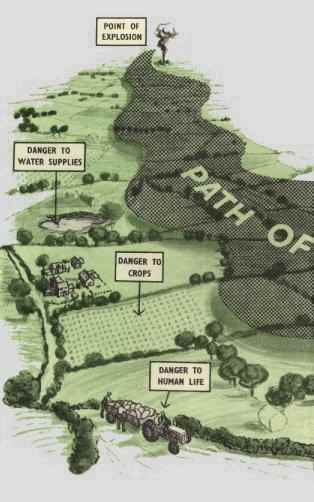

The continuance of food production on farms affected by fallout could well depend upon the practical steps taken by each farmer and his staff at a time when they would be on their own, with no one to turn to for advice or help. The handbook can only suggest in general terms how livestock and crops could be safeguarded. If an attack came, farmers in all parts of the United Kingdom would suddenly be faced with new and major problems. On their solution, our survival might well depend.
Although mainly concerned with farming
matters, the handbook also deals briefly with the danger
to the farmer and his family from radioactive fall-out
and how they might protect themselves. There is much more
information on these non-farming aspects of civil defence
in the Home Office publications The Hydrogen Bomb and
Nuclear Weapons.
The Hydrogen Bomb, H.M.
Stationery Office, 1957. (9d.)
Nuclear Weapons, H.M. Stationery Office, 1956 (2s. 6d.) |
These handbooks do not
deal with all the difficulties that would face farmers if
this country were to be attacked with hydrogen bombs. In
addition to the fires, destruction and fall-out, there
would certainly be serious shortages of farming
requisites and difficulties in moving farm produce.
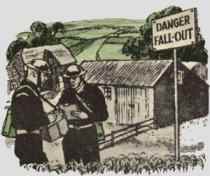
The handbook also does not deal, except in passing, with the Government's plans for dealing with the consequences of radioactive fall-out on farms; for example, measures to deal with the large numbers of livestock that may sicken or die as a result of radiation; plans to control the movement of farm produce which may be dangerous through contamination by radioactive material. These, and other defence plans affecting farming, are being worked out on the basis of facts such as are presented in the following pages.
It is important that a clear distinction should be made between fall-out which would arise if this country were attacked with nuclear weapons and fall-out resulting from the peace time testing of such weapons. Deposits of radioactive fall-out in peace time, although measurable, are both infinitesimal and negligible in comparison with what might be expected in war time, and it is accordingly emphasised that this handbook deals only with problems associated with the war time hazard. The same problems do not arise in peace time.
Dangers from atomic or hydrogen
bombs
When an atomic or hydrogen bomb bursts, there is a
very great destruction from fire and blast for several
miles around. But there is also another kind of danger
which can affect a very much larger area. This danger
comes from radioactive fall-out from the bomb.
Radioactive fall-out
If a hydrogen bomb or atom bomb explodes on or near
the surface of the earth, masses of soil and debris are
drawn upwards to form a great cloud very high in the air.
This cloud contains radioactive particles produced by the
explosion; that is to say, particles which give off
radiations rather like X-rays. These radiations can harm
human beings and animals. Some of the particles are very
fine, like dust, and others are much bigger. The bigger
particles quickly fall to earth again near to where the
bomb exploded, but high in the air the fine particles are
blown along by the wind, just as chalk dust is blown
about when a farm is being limed. These fine particles
slowly come down to earth, all the time giving out their
harmful radiations. Fall-out is the name given to
this fine dust.
In the case of an attack with hydrogen bombs, the fall-out might spread over a very large area, stretching for hundreds of miles downwind from where the bomb bunt. Usually you would not be able to see this fine radioactive dust, even though it was falling on to your house, your buildings, your fields and your animals. Neither could you hear, feel or smell fall-out. Nevertheless, the dangerous radiations would still be there and they could be detected on special instruments. But if you did see a dust cloud after a bomb had gone off, you should take shelter at once.
Fall-out is dangerous
Fall-out is dangerous because every particle of it
gives out rays like X-rays which can damage or destroy
the living cells of the human body. It is more harmful
the nearer you are to it) or if it gets on your skin or
clothing. The rays can penetrate the walls of a building
to some extent, but even so you are much safer inside a
building than outside.
It is also dangerous to swallow fall-out in food or water. This is because once fall-out gets into your body, some of it will stay there; all the time it is there its rays are attacking the sensitive internal organs of the body and illness or death may result.
Danger to animals
Animals are harmed by fall-out just as are human
beings. Indeed, they would probably be affected more
severely because, unless they were in buildings, they
would be exposed to the full effect of the radiation day
and night. Most human beings would be able to protect
themselves by taking shelter.
Danger to milk supplies
If livestock were grazing pasture on which there had
been fallout, not only would they be exposed to the
radiation from the fall-out on the ground around them but
also internally from the fall-out on the grass they had
eaten. Some of this fall-out would pass through their
bodies, but some would be retained and continue to cause
damage. In the case of dairy cows, some of the fall-out
would pass through the cow to the milk. It would be
dangerous for human beings to drink such milk, even
though the amount of radioactive material in it might
only be small. In fact, even in districts where the fall-out
was not sufficiently severe for it to cause any direct
harm to human beings, cows might pick up sufficient fall-out
on their grazing to make their milk dangerous for humans,
and particularly infants, to drink.
Other effects of fall-out on farming
If H-bombs were exploded over this country, people in
the very heavy fall-out areas would have to leave after
being in refuge for forty-eight hours, and they would not
be able to return for a considerable time.
People in the less badly affected areas would still have to stay in refuge for forty-eight hours and, after that, would not be allowed out for more than an hour or two a day for the next few weeks.

TYPICAL FALL-OUT PATTERN
This diagram illustrates the fall-out pattern from an H-bomb supposedly dropped on the north-west coast, with the wind blowing from a generally westerly direction.
In the lightly contaminated areas, people would be allowed greater freedom after the first forty-eight hours but should not spend more time in the open than was thought by their wardens to be safe.
In some districts losses of livestock would be serious; sowing of crops might be delayed and some time might have to elapse before harvesting could take place. The growth of crops would not be greatly affected in most of the fall-out areas, though the fall-out on them might make them unfit for consumption by humans or animals. It might be necessary to suspend marketing crops for the time being until they had been tested for radioactivity and found to be safe. The Agricultural Departments are training some of their staffs to be able to carry out this testing.
Fall-out warning
Unless it were a misty or rainy day, many people
miles away would see the great ball of fire which would
rise into the air after a hydrogen bomb had exploded, and
with it the vast mushroom-shaped cloud of dust and debris
that would contain the fall-out. The direction which the
fall-out cloud would take would depend on several factors,
including the direction and strength of the winds at
ground level and up to heights of 80,000 feet or more,
where the wind directions might be very different from
those near to the ground.
People who saw the mushroom-shaped cloud would do well to make ready to shelter in case fall-out followed in their area. Plans are being made to give the public warning of the approach of fall-out.
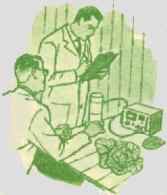
What protection is there against
fall-out?
There are three simple facts about fall-out:
1. The rays from fall-out become less dangerous as time goes on, and, in particular, they lose most of their power within two days of the explosion of the bomb. For example,
100 units of radiation 1 hour after a bomb goes off would be reduced to about
10 units 7 hours later, and still further reduced to
1 unit after 2 days.
Even so, if the fall-out had been particularly heavy, it might still be dangerous to be out of doors after forty-eight hours.
2. The rays are less intense the further you are away from fall-out. If you could keep a distance of 12 feet or so away from the nearest fall-out, you would receive only about two-thirds of the radiation you would otherwise get.
3. The rays are markedly absorbed by heavy materials like brick, concrete and earth. A person shielded by a foot of concrete or 15 inches of brick or 18 inches of earth would receive only one-twentieth of the dose he would get if unprotected.
What do these facts mean in working out how to protect yourself against fall-out?
First of all, if you were in a fall-out district, you would have to stay indoors until told by a civil defence warden, or the radio, that it was safe to come out. Shelter in the cellar if you have one or, failing that, in a protected room on the ground floor of your house.
Secondly, if you and your family were in a shelter with walls giving the equivalent protection of concrete a foot thick and which was such that the fall-out on the ground outside and on the roof was nowhere nearer to you than about 12 feet, the radiation received in the shelter would be only one-thirtieth of that outside in the open. Moreover, by staying inside for the first two days, you would have been having this thirtyfold protection during the time the fall-out was most dangerous. The radiation after two days would be only one-hundredth as dangerous as it had been just after the explosion.
There are two other rules to observe about protection. The first is to keep fall-out off your skin and clothes. When it is on or near your body, it can cause serious burns. So if you believed you had fall-out on your clothes or body, you should change into other clothes at once and wash very thoroughly. The other, and most important, rule is to avoid getting fall-out inside your body, whether through a cut or on food or in water. Once it is inside your body, the radiations can do very great damage to the internal organs and bones.
These rules, and the advice about sheltering in the most substantial building available, can be used to work out measures for protecting your livestock as well as your family.
Even when you were told it was safe to come out of shelter, it might still not be safe to stay out of doors very long. Your warden would tell you whether you could get on with your work without further risk from radiation or whether your farm was in an area where the fall-out had been very heavy and where it would be necessary either for you to leave your farm for a time or, for your own safety, not to spend more than a few hours a day in the open for the time being.
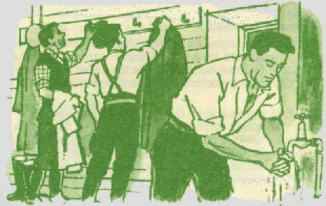
Although fall-out would be very dangerous, there are some useful precautions you could take to protect your family and your farm. Not all farms would be affected, but it is worth while taking these precautions because if hydrogen bombs were to explode in this country a very large number of farms would be affected to a greater or less extent and yours might be one of them. Moreover, many of the measures that would reduce the risk from fall-out are also good farming practice in peace time and worth adopting purely for their peace time value.
For example, in peace time, well-managed pasture or fodder crops lead to lower production costs; in war time, livestock would come to less harm from fall-out in grazing a thick quick-growing pasture or fodder crop than if they were on a poor pasture where they had to graze a large area to get their food. The farmer with ample silage and hay would be able to feed it to his dairy cattle and avoid or delay putting them out on to contaminated pasture.
Even the layout of buildings, yards and roads would help, not only in peace time but in fall-out conditions in war time. A good layout would help the farmer and his men to reduce the time spent out of doors and so minimise the dose of radiation they might receive. So efficient farming is not only in the national interest and the farmer's interest in peace time, but it is a way of preparing for safer farming if another war should occur.
If you had a few months' warning of
the possibility of war
Supposing there were to be a few months' warning of a
war, these are some of the things you could do to make
your family safe if fall-out should come:
Get ready to act on the advice in this handbook, and make sure you arrange things so that you can make the best use of a few hours' warning of fall-out.
Make your cellar habitable and as comfortable as you can. If you haven't a cellar, prepare a refuge room in the house. Keep a stock of tinned and packaged food in your house and some containers to hold drinking water for your family. A supply for two or three weeks would be a wise precaution. A stock of soap would also be useful for personal decontamination if you were to get fall-out on your skin.
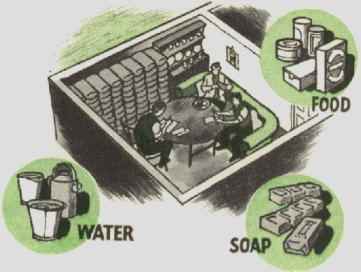
These things would help to make your farm safer if fall-out should come:
Work out in advance whether you have shelter for dairy cattle and other livestock; try housing them one day to see how long it would take.
Remember that the fall-out might be so dangerous that you would have to stay indoors for two days after it came down. This means that you might not be able to get out to milk your cows and they might be in considerable pain by the time you could milk them again. Probably the best thing you could do would be to provide yourself, or one of your men, with a protected shelter (for example, a loose box protected by a thick layer of earth) in the cowshed and equip it with a bed. Whoever stayed in it could leave it for long enough to ease the cows if they were in pain, but milking should be left as late as possible in the two-day period to allow the intensity of radiation to die down before leaving the comparative safety of the shelter to work in the less well protected cowshed. If necessary the milk would have to be wasted.
Arrange your farming so that essential things are near the house or near the livestock buildings. For example, a mains tap outside the buildings (or better still, inside them), might be very useful. Have your silage pits as near as possible to the buildings where your livestock would be sheltering from fall-out; the shorter your journey in the open, the less exposed to fall-out you would be. But in siting your haystacks, remember the risk of their being fired either by a bomb or through natural causes. Have a store of fodder always inside your buildings, and if the roofs are poor, have some tarpaulins ready to put over them.
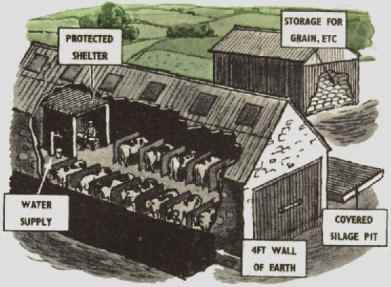
A wall of earth 3 or 4 feet high against the livestock buildings would add to the protection against radiation which the walls would give your livestock. For example, a potato clamp built against walls of a building would be useful protection.
Store as much clean water as you can for your animals which are under cover. It must be near the buildings. If you have a well, see that it is kept clean and covered. Put some tubs and other containers beside your buildings and keep them covered. Fill them regularly with clean water.
Get hurdles or fencing ready so that cattle could, if necessary after the attack, be confined to a small area of grazing.
Make sure any seed or grain is in a weatherproof building into which fall-out would not penetrate, and that your windows, doors and roofs are in good repair or covered over.
If you are short of shelter for your livestock and have a Dutch barn, build up bales of straw at the sides and ends. The straw would not stop the radiation from fall-out to any extent, but the makeshift walls would reduce the risk of fall-out dust getting on the coats of animals sheltering under the barn and would keep the fall-out at a distance from them.
Try to have some satisfactory storage space for fuel (a fuel tank is a good investment in peace time), fertilisers, feeding-stuffs and seeds. If there were to be a few months' warning of a war it might be possible to arrange with the trades concerned to move supplies of these requisites on to farms.
If a war threatened, the Government would supply you with more detailed advice about the farming problems you might have to face and what it would want you to grow. There might be time for you to adjust your farming programme accordingly.
Warning, after an outbreak of war,
of the approach of fall-out
First of all, make arrangements for the safety of
your family, your workers and yourself. Don't forget to
take enough farm and garden produce into the house to
last you for a week or two. Keep a spare set of clothes
handy which you would use only outside the house;
by changing them when you came in, you would avoid taking
fall-out into the house. If you have made a protected
shelter in the cowshed, make sure that there is some food
and water in it.
THESE
ARE THE THINGS YOU MIGHT
SEE TO ON THE FARM
Livestock
The nation would need all the clean milk it could get.
Therefore get everyone busy first bringing in the dairy
cattle and the calves if possible into a building by
themselves. Then, if you can, get your other livestock
into buildings or a yard or, failing that, to a small
field. If any animals had to be left in the open choose a
sheltered field. Trees would give some protection.
Do what you can to reduce the milk yield of your cows temporarily to ease their pain, in case you cannot get out to milk them for a day or two.
Thus:
Milk them out before leaving them.
Leave just sufficient food to keep them alive; it would be best to give them poor quality fodder, such as straw. The supply of water to drinking bowls should be cut down.
Wherever possible, house any calves you have with the milking cows so the cows can suckle them.
Other animals can have food and water if you have time to get any in, but give them as little as is necessary to keep them alive. You may need all the clean food you have for feeding dairy cattle if the fall-out comes.
Fodder
Bring under cover as much food as possible for your
live-stock, or put a tarpaulin over it (for example, if
you have an open silage pit or any grain in stack).
Water
You cannot rely in advance on a continuing mains
supply-therefore store as much water as possible. Well
water is likely to be safe if you have put a cover over
the well to prevent contamination by fall-out. But if the
well had not been in use for some time, you should boil
the water or add hypochlorite at the rate of ½
teaspoonful to 10 gallons of water before using it for
human consumption. If you have a rain-water butt make
sure that you can turn the spout away so as to stop the
rain washing fall-out from the roof into your clean water.
Cover the butt itself. If you have a stream running
through your farm you need not worry so much about water
for your livestock, as the stream is likely to be safe
for livestock to drink, especially if it is fast flowing.
Implements and Machinery
If you still have time, bring your vehicles and
tractors near to the farm-house and under cover if
possible; alternatively, cover them with tarpaulins or
sacks. But only bother with machinery and implements
after you have seen to your livestock. Food and water
come first.
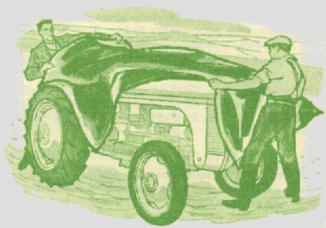
If there were to be an attack on this country with nuclear weapons, and you had had to shelter from fall-out, you would want to know, when you were told it was safe to leave shelter:
whether the food on your farm would be safe to eat;
what you could do to reduce the risk from fall-out; and
what you ought to be doing on your farm.
FOOD FOR YOUR FAMILY
The food in your larder would be safe to eat, provided it was in sealed containers or otherwise protected so that no dust from outside could get on to the food.
There would also probably be food on the farm which you would want to use if you knew it was safe to eat or knew how to make it safe.
The following paragraphs give some advice on dealing with food produced on your farm.
 MILK
There would be a very great
risk in drinking milk from cows which have eaten food
contaminated by fallout. If your family badly needed milk,
it should be given to them only if you were sure that
your cows had been under shelter before the fall-out came
down and had not left it since, and that they had had
only food and water on which there could have been no
fall-out dust.
MILK
There would be a very great
risk in drinking milk from cows which have eaten food
contaminated by fallout. If your family badly needed milk,
it should be given to them only if you were sure that
your cows had been under shelter before the fall-out came
down and had not left it since, and that they had had
only food and water on which there could have been no
fall-out dust.
 EGGS
It would be safe to use eggs
from poultry that had been under cover the whole time
since the fall-out came down. It would not be quite so
safe to use eggs from poultry on open range, but they
could be used if badly needed as food, since the risk
from fall-out would be only slight.
EGGS
It would be safe to use eggs
from poultry that had been under cover the whole time
since the fall-out came down. It would not be quite so
safe to use eggs from poultry on open range, but they
could be used if badly needed as food, since the risk
from fall-out would be only slight.
 POTATOES AND ROOTS It would be safe to use fully grown potatoes and
root crops ready for harvesting, provided they were well
washed to remove all soil particles and also peeled. It
is important that the fall-out should be removed; it is
not destroyed by boiling or cooking (see below-'Growing
Plants').
POTATOES AND ROOTS It would be safe to use fully grown potatoes and
root crops ready for harvesting, provided they were well
washed to remove all soil particles and also peeled. It
is important that the fall-out should be removed; it is
not destroyed by boiling or cooking (see below-'Growing
Plants').
 GREEN VEGETABLES It is better not to eat green vegetables which
might be contaminated by fall-out. But if in the first
few days after the attack you had to take the risk of
eating green vegetables choose only plants with solid
hearts such as cabbage, sprouts and lettuces. Several
layers of the outer leaves would have to be removed and
the heart washed thoroughly before cooking. The discarded
leaves should not be kept indoors. Loose-hearted cabbages,
etc., would not be fit to use, as there might be fall-out
on the leaves. In dealing with all garden produce, it
would be advisable to wear gloves, preferably rubber, to
keep contamination away from the skin. You should scrub
your hands paying particular attention to your nails.
GREEN VEGETABLES It is better not to eat green vegetables which
might be contaminated by fall-out. But if in the first
few days after the attack you had to take the risk of
eating green vegetables choose only plants with solid
hearts such as cabbage, sprouts and lettuces. Several
layers of the outer leaves would have to be removed and
the heart washed thoroughly before cooking. The discarded
leaves should not be kept indoors. Loose-hearted cabbages,
etc., would not be fit to use, as there might be fall-out
on the leaves. In dealing with all garden produce, it
would be advisable to wear gloves, preferably rubber, to
keep contamination away from the skin. You should scrub
your hands paying particular attention to your nails.
![]() PEAS AND BEANS Only
the pods of peas and beans would be contaminated. The
peas and beans inside would be quite safe to eat.
PEAS AND BEANS Only
the pods of peas and beans would be contaminated. The
peas and beans inside would be quite safe to eat.

But in the case of growing plants there would be the danger after the first few days that potatoes and other root crops, as well as peas and beans and the leaves of cabbages, might be contaminated by radioactive material which had been taken up through the root system from the soil (see Fall-out in the growing season). If the fallout came during the growing season it would be better to have the crops tested for radioactivity before eating them. But if food was so scarce that you had to eat growing plants which might be contaminated, it would be safer to use potatoes, then peas and beans, then green vegetables, in that order.
REDUCING THE RISK FROM FALL-OUT
There is no known way of preventing the fall-out from giving out its radiations, nor of speeding up the rate at which the intensity of the radiations dies away. All you can do is to move the fall-out to a place where it can do least harm.
In the few hours each day when it would be safe to be out, your first job would be to see to your livestock. Then if you had plenty of water you could hose down the roofs and buildings, also any made-up surfaces or hard roadways there may be around your buildings. If you had little or no stored fodder, some nitrogen could be put on to a well-grazed pasture. It would speed up the growth of new grazing, which would be very much safer than the older grass that was there when the fall-out came down. Or you could mow some grass, cart it to a place where the animals could not get it and put some nitrogen on the field to encourage new growth.
It would be useful to keep a set of old clothes and rubber boots for outdoor use and to change when you got back home. They should be left in the porch on going indoors. When working, outside gloves should be used, preferably rubber ones, but in any case it would be most important to wash your hands well before eating and to scrub your finger nails well. If you were doing a dusty job - ploughing or cultivating dry land, or threshing or grinding corn or stacking hay - a handkerchief or a simple dust filter should be worn over nose and mouth, and ears should be plugged with cotton wool. Afterwards the nose and ears should be thoroughly cleaned.
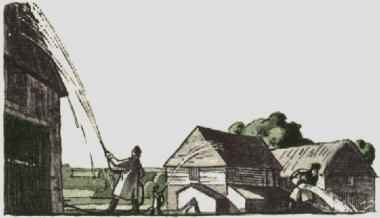
Persisting dangers from fall-out
Even several weeks after the fall-out had come down
and when the danger from external radiation might have
died away, it would still be important that farm produce,
especially milk, should be tested for radioactivity,
unless you were advised otherwise by the Agricultural
Departments. This is because fallout consists of a
mixture of many chemicals. All are radioactive. Some of
these chemicals soon lose their radioactivity and so the
intensity of the harmful rays being given off by the fall-out
as a whole diminishes fairly quickly. Even so, if much
fall-out had come down on your land, the rays might
remain dangerous for several months. But if your land was
only slightly contaminated, the danger from external
radiation might last only several hours. This would not
mean that all fall-out had ceased to give off rays. A
small part of it, made up of those chemicals which lose
their radioactivity only slowly, would still be giving
off rays and you should take precautions to keep the fall-out
away from your body.
One of these chemicals, called radioactive strontium, retains its radioactivity for many years. If it got into your body some of it would go into the bones and stay there, all the time giving out radiations which might eventually cause illness or premature death. That is why it is important for food to be tested for contamination before marketing. It is specially important that milk should be tested for radioactivity. This is because even though the amount of radioactive chemicals remaining in a fall-out area might be small enough to permit lifting any restrictions on the length of time people could be outside, dairy cattle on free grazing would collect these chemicals from all the grass they would be eating. In this way they might swallow dangerous amounts of the radioactive strontium, some of which would get into their milk.
If your cows had been under shelter and had had food and water which had had no fall-out dust on it, their milk would almost certainly be safe. Even so, it would be better for it to be tested before it was supplied to the public.
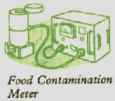 In
war time the country would need all the food it could get
and you should try to avoid wasting any milk produced by
your cows. Milk which was found on test for radioactivity
to be contaminated, or about which you were doubtful and
could not get tested, could be made into cheese or better
still, butter, if you had facilities for doing so. This
would have to be tested for radioactivity later on. If
you had spare churns the milk could be kept for a day or
two until it could be tested. Contaminated milk, whether
whole or separated, could be fed to pigs and steers. This
is because its radioactivity is unlikely to do them very
much harm before they reach the age at which they are
ready for the butcher.
In
war time the country would need all the food it could get
and you should try to avoid wasting any milk produced by
your cows. Milk which was found on test for radioactivity
to be contaminated, or about which you were doubtful and
could not get tested, could be made into cheese or better
still, butter, if you had facilities for doing so. This
would have to be tested for radioactivity later on. If
you had spare churns the milk could be kept for a day or
two until it could be tested. Contaminated milk, whether
whole or separated, could be fed to pigs and steers. This
is because its radioactivity is unlikely to do them very
much harm before they reach the age at which they are
ready for the butcher.
WHAT ELSE TO DO ON YOUR FARM
This handbook is intended to help you through the first few difficult days, or the week or two just after fall-out had come down. It does not deal with the longer-term problems such as how best to get a badly contaminated farm back into production again. This and other problems could best be tackled by advice on the spot in the circumstances of your farm.
Agricultural and other Government Departments are making plans for you to be given advice and help locally on the problems that would face you if ever there should be another war. But in the short term, the advice in this handbook, and that of your warden, would help you in the very difficult conditions that would exist after an attack with nuclear weapons. As long as it was safe to be outside - and your warden would tell you about that - it would be safe for you to carry on farm operations and to harvest your crops. Priority would have to be given to producing uncontaminated milk; remember that a thick, quick-growing pasture would help to reduce the risk from fall-out to the grazing animal.
The remainder of this handbook consists of information on practical questions which farmers are likely to ask about the threat from radioactive fall-out to particular farm enterprises in which they are interested. Though much of the information can be deduced from the facts about fall-out already given, the additional details will probably help farmers to make plans to tackle these entirely new problems, should they ever occur.
If you want further advice, ask your local agricultural officer.
If you are able to get your cows under cover, keep them there as long as possible, and preferably until you are advised that it is safe for them to go out to graze. If a shortage of feedingstuffs forces you to put out your cows earlier, it is better to put them on as small an area as possible, even though it would mean a ternporary loss of milk production, so as to reduce the amount of fall-out getting inside the animals and into their milk.
Should cows be dried off rather than
continue in milk on a contaminated farm?
The advice given above would reduce the yields of
milk. But during the time the dairy cattle were being fed
on stored food (if your silage pit or haystack had not
been protected, it would still be safe to feed your
cattle on them, provided the surfaces exposed to the
atmosphere were removed.), you should cut and cart away
the grass from your pastures, especially if the fall-out
had come in the summer when growth was quick. This
treatment would remove most of the fall-out from the
pastures. Your cows could then graze the new grass as it
grew. The grass taken off could be made into hay or
silage and tested later to see whether it was safe to be
used for fodder. If you had to put your cows outside
without being told it was safe and if you had been unable
to cut the grass, another way to reduce the amount of
fall-out getting into their milk would be to let other
livestock graze the area first.
Even if your cows had to be on contaminated pasture for a time, provided they did not take in sufficient fall-out to cause illness or death, they would still be able to give uncontaminated milk later on. Once they had got back on to an uncontaminated food supply, the amount of radioactive chemicals in their milk would be reduced each day until after a few weeks their milk should be fit for human consumption, though it would need testing first.
Would contaminated milk make milking
machines unfit for use?
No. The ordinary thorough cleansing given to milking
machinery and milk containers would be satisfactory.
Are them special precautions for
handling dairy cattle and other livestock exposed to fall-out?
Yes. If your animals had been exposed to fall-out,
their coats would have trapped the dust, and you should
wash your hands thoroughly after handling them. Where
practicable, the best thing would be to clip their hair
or hose them down. Sheep dips or disinfectants give no
protection against radioactivity. When milking, you
should use rubber gloves and wear overclothes, such as an
overall or mackintosh. The gloves should be washed after
use and the overclothes left outside the farmhouse. You
would have to be very careful to prevent dust, hairs, etc.,
from falling into the pail if you were hand milking.
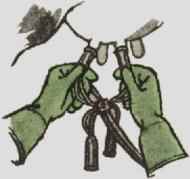
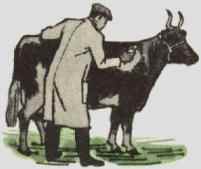
What is radiation sickness?
Radiation sickness is not infectious but it would reduce the resistance of the animal to other infection. If your livestock had received a heavy dose of radiation, whether entering their bodies from outside or because they had eaten feed contaminated with fall-out, they might sicken and die within a few weeks. Their flesh would be edible if they were killed before they became very sick. Even if they did not die as a result of the radiation, they would not make thrifty animals again and better use could be made of the feedingstuffs they would consume if they were allowed to live.
In areas where the level of radioactivity made it likely that a high proportion of the cattle would suffer from radiation sickness, arrangements would be made for the slaughter of the cattle and suitable disposal of the bones and offal as soon as practicable and possibly before any signs of radiation sickness had become apparent. You would be told if such arrangements were being made in your area and be given full instructions.
It would in fact be better not to slaughter until you had had some official advice, as it would be easier to preserve meat on the hoof than on the hook in the early days of a war of this nature and to keep animals alive would help the Government to organise a fair meat distribution.
How would you know if livestock had
radiation sickness ?
Radiation sickness is caused by radiation received
externally or by radiation received internally through
swallowing fall-out. Animals which had had a dose of
radiation severe enough to cause radiation sickness would
show irritability, diarrhoea, loss of appetite and apathy.
These symptoms might appear within a few days of the fall-out
coming down or might be delayed a week or two, according
to how heavy the fall-out was in your district or how
much had been ingested.
Would poultry, pigs and sheep be
affected by fall-out to the same extent as cattle?
Approximately, yes. Again, although they might get
radiation sickness, their flesh would be fit to eat. This
is because the radioactive material which is retained in
an animal's body goes into bones, and to its internal
organs rather than to the flesh. If you killed any
livestock for your family's use, you should not use the
bones or offal for food.
Is there any treatment for radiation
sickness?
For animals, no. But for humans, rest, good food and
good nursing are the best treatment.
How long would it be before it would
be safe to use milk and eggs from cows and poultry that
had eaten feed contaminated with fall-out?
It is impossible to say, unless it is known how much
fall-out they had swallowed. The safe answer would be to
suspect all milk for human consumption until you had had
expert advice.
If you could not send eggs to a packing station it would be best to put them into waterglass and store them until they had been tested. The risk of dangerous contamination in an egg, is, however, very small. They could be used if urgently needed for food.
Has fall-out any effects on breeding?
For a few weeks after exposure to massive doses of
radiation, the male animal is still fertile. If it is
used during this period there is a chance that its
offspring might be abnormal in some way. But if the
animal appears to be vigorous and healthy it is unlikely
to have received a massive dose. After this period of
fertility, the male animal may become partially or wholly
sterile, perhaps for as long as a year or so, after which
it is likely to recover its fertility.
With heavily contaminated female stock, some may become permanently sterile, others will remain fertile but with a chance that in some future generation, probably beyond our life-time, abnormal offspring may result. For breeding, then, the best course would be:
use the A.I. service if it is operating in your district;
do not use your male livestock for mating until several months after the attack, if they have obviously been affected;
if possible, use stock for breeding which has been under cover and away from fall-out.
You would be unlikely to see many ill-effects if you were to breed from contaminated stock. It would be better to use your bull than not to get your cow in calf, as the country would need all the milk your farm could produce.
Would fall-out affect hatching eggs?
It would be better to use eggs from birds that had
been exposed to fall-out than to stop breeding, but you
should try to breed from eggs from birds that had not
been exposed to radiation or had not picked up fall-out
whilst on open range.
In most areas the radiation from fall-out would not materially affect the growth of crops or damage seeds or young plants, but the crops might not be fit for human or animal consumption when harvested. Produce (except eggs, if needed) should not be marketed until tested for radioactivity.
If it were safe to be outside, it would be safe to prepare the ground for your crops, to sow seed or to plant out or to harvest crops, provided you took the precautions about washing. Also, if your crop was not planted when the fall-out came, it would be advisable to plough in the top soil so as to bury the fall-out as deeply as possible before planting. If you had a dusty job to do, and there are many on the farm, you should remember to wear a dust mask and to wash thoroughly afterwards.
Grain, potatoes or other roots stored in weatherproof buildings would be safe to eat. Roots in clamps would be safe to eat if after removal from the clamp all the soil were washed from them. Grain in stack would also be safe to use if several layers of sheaves from the roof were discarded and the outsides of the stack pared.
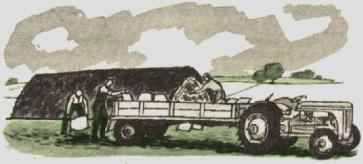
Fall-out in
the growing season
In the growing season the fall-out might be taken
into the plant either by the roots, if there were fall-out
in the soil, or by absorption through leaves on to which
fall-out had fallen. This would not make the plant
dangerous to handle, but it might possibly be enough to
make it dangerous to eat, especially in the case of leafy
plants where the leaf is the part normally eaten.

Fall-out just before harvest time
Fall-out at this time might make some crops dangerous
to eat, particularly where the parts exposed to the fall-out
are normally eaten. Fall-out might stick on to the heads
of corn or to the leaves of green vegetables. Rain would
be unlikely to wash it all off. If the fall-out came just
before harvest you should not market any vegetables or
cereals until you had had advice. It would be better to
delay harvesting if you were unable to store the crop.
Harvesting
If you were in an area so severely affected by fall-out
that at first you had to stay indoors most of the day, it
would be safer to wait a week or ten days after the
attack before harvesting the crop. Elsewhere, crops could
be harvested as soon as they were ready. But in all cases,
if there had been fall-out on your crop, it should be
kept on your farm until you had had advice.
It would be best to harvest a contaminated cereal crop with a combine, since this would be a less dusty job than handling sheaves. Whatever method you used you should take the precautions for your own safety described in the section Reducing the Risk from Fall-out.
Sometimes a crop might be saved for food, even if it seemed to be badly contaminated. Thus contaminated cereal crops might at least be partly decontaminated in the threshing process, which would remove the chaff, the part on which the fall-out had fallen. If there was a grave shortage of food in your district and your cereals had to be harvested to give an immediate emergency supply of flour, even though it was known they might be slightly contaminated, threshing would help to make the crop safer.
Potatoes
Potatoes (that is, the tubers themselves) and other
roots would not be likely to contain fall-out. If it were
safe to go on your ground it would be safe to harvest
your root and potato crop, but the roots should be
thoroughly washed before use.
Are there any genetic effects on
seed exposed to fall-out?
For practical purposes you need not worry about this.
Just sow your seed as usual.
Would it be safe to plant by hand in
contaminated soil?
If it were safe to be out, yes. But wash well
afterwards.
Would the use of sprayers help to
remove the fall-out from the top soil?
Not to any appreciable extent (experiments are being
carried out to find out whether deep ploughing or some
other method offers often the best means of removing fall-out
from the top soil). But it would be worth spraying the
yards near the house with water to keep the dust down and
wash it away.
Should crops growing in contaminated
land be limed and fertilised?
Yes, just as usual. The better your crop does, the
less would be the amount of the dangerous radioactive
chemicals in each unit of weight of the crop.
Your warden would tell you how long you and your men could safely stay outdoors. Do not exceed this time - use it for essential outdoor work. During the periods each day when you had to stay indoors, it would be almost as safe to work in your outbuildings provided they are at least as big and well constructed as a house. Buildings with asbestos, wood or corrugated iron sides would not give much protection against radiation from fall-out, and any time spent in them would have to be counted as part of your outdoor time. The higher the building the better; a high roof keeps the fall-out further away from you.
See that your men know about wearing dust masks, gloves, changing their clothes and washing after being out of doors. These simple precautions would reduce the risk appreciably. After dusty work or handling livestock it would also help if your men could change at the farm and travel home in clean clothes or at least change as soon as they reached home.
Arrange your work so that your men have as little travelling to do as possible. The time they take to get from their homes to your farm counts against the time they could spend in the open. The single men might be willing to live in the farmhouse for a week or two to reduce their travelling time and so be able to spend longer on essential jobs. A shift system to reduce travelling time might be feasible.
Is it necessary to change the
cropping rotation because of fall-out?
The roots of some crops do collect fall-out from the
soil more than others. But the best- thing to do would be
to carry on as usual unless the Agricultural Departments
advised you otherwise, either through their local
officers or on the radio. Cropping policy in war time
would be influenced by other factors than the effect of
fall-out on particular crops
Arrangements the Government is
making to advise you about your farming
The Agricultural Departments are training some of
their staffs to help you to deal with all the problems
discussed in this handbook, and to advise you about your
farming. These trained staff, like the warden and
everyone else, would have to take shelter from fall-out.
But afterwards, they would tell you whether your land and
produce were badly affected by fall-out and what to do
about them. And when the first few days and weeks were
over, and the main danger from fall-out had gone, they
would help you to tackle the other problems that might
then beset your farming.
Published by Her Majestey's Stationary
Office
PREPARED BY THE MINISTRRY OF AGRICULTURE, FISHERIES AND
FOOD
AND THE CENTRAL OFFICE OF INFORMATION
Printed in Great Britain under the
authority of Her Majesty's Stationary Office
by the Curwen Press Ltd., Plaistow, E.13.
Wt. 3692
S.O. Code No. 24-271*
PRICE ONE SHILLING NET
First published 1958: Reprinted 1959
|
This document is believed to be in
the public domain and was transferred to the Internet by
George Coney.
Last updated June 1999
Send mail to atomic@cybertrn.demon.co.uk



